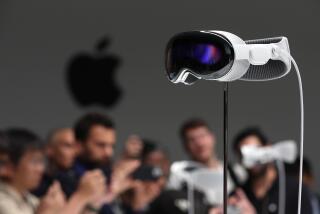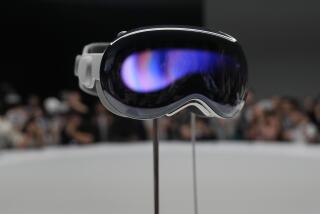Cutting Edge: 360-degree camera makers are focusing on the consumer market
Jim Malcolm pulls up a video on his smartphone he recently shot at Disneyland.
At first, it looks like a typical family vacation video: We see a ride from Jimâs point of view as a carriage whooshes into tunnels and back out again.
With a swipe of his finger, the camera spins around and we see Jimâs face â same ride, different angle.
He puts his finger on the phoneâs screen and drags it down, and now we can see his kids sitting behind him on the ride, broad grins as the wind laps against their faces.
Malcolm didnât use a traditional camera to shoot the footage â that would have required too much turning back and forth.
Selfie stick? Disneyland banned those.
GoProâs $15,000 360-degree camera array with 16 GoPro cameras mounted onto a tripod? Uh, no.
âThis was all I used,â he said, holding a slender device that looked like a cross between a voice recorder and a chubby Apple TV remote. âA lot of cameras can do 360-degree video in one direction but not all directions,â he said, referring to cameras that capture images only on the horizontal plane, leaving out anything above or below the camera (the âdoughnutâ effect). âThis gets it from all directions. This camera leaves nothing out.â
You might expect Malcolm to be all excited by the camera. He is president of the American arm of Ricoh Imaging, the electronics company historically known for projectors, printers and, after its acquisition of Pentax in 2011, film and digital cameras. The device in his hand is the Ricoh Theta S, a camera with two lenses that captures images and video in 360 degrees. It is slated to launch in November at $349.99, making it one of the first 360-degree consumer cameras.
But whatever the merits of this particular camera, any objective observer would have to agree that the video is pretty cool.
Malcolm demonstrates how he recorded the footage, holding the Theta S slightly above his head.
âIt has a six-way accelerometer and compass,â he said, moving the camera through the air like a magic wand. âSo not only do we know data from the location of the camera, we also know orientation and direction of the camera.â
It is, as he says, consumer-friendly. Just stick the camera out, push a button, and it captures everything.
If elaborate 360-degree camera rigs such as the GoPro Array are on the cutting edge of video technology, then consumer versions are on the edge of even that.
Although movie studios and other professional content creators can afford $15,000 camera rigs, the average consumer cannot. Although professional content creators might have the infrastructure and patience to use a rig that consists of 16 cameras, average consumers do not. And if the success of past consumer cameras is anything to go by, in addition to being affordable and portable, they also have to be easy to use and easy to share.
These are some of the challenges 360-degree camera makers face. And these are the challenges theyâre starting to overcome.
To keep the camera small, Ricoh uses two lenses in the Theta S, each capable of seeing 190 degrees. To keep it thin, Ricoh created a âfolded optical pathâ using an optical prism, enabling the image to travel into the lens, turn a corner and hit the cameraâs sensors that are built into the side of the device.
âBy folding the optical path, weâre making it optically longer without having to make the camera bigger,â Malcolm said.
Other consumer camera makers are also giving it a shot. 360fly, a black, orb-like camera, went on sale at Best Buy last month. It also captures video footage at all angles but uses only a single lens and, unlike the Theta S, is waterproof. The 360fly is selling for $399.99.
Bublcam is another 360-degree, ball-shaped camera with multiple lenses slated to launch this year for $799.
Then thereâs Giropticâs palm-size 360-degree camera that resembles a childrenâs toy with three eye-like lenses. Itâs available for pre-order at $499. A launch date has not been announced.
Although none of the cameras can shoot at the quality of devices used by companies such as NextVR, which uses multiple Red cameras to live-stream 360-degree video (Red cameras start at $5,000 and can go up to $50,000), the Theta S and the Giroptic can capture in high definition. The 360fly can hit nearly 30 frames per second, which is not too shabby for something that fits in your pocket.
But according to analysts, the biggest hurdle camera makers have to overcome isnât on the hardware side; itâs on the software and people side.
Any device that uses multiple cameras needs software that can seamlessly stitch the images together. And once the images are created, there needs to be a way to view and share them.
âPart of the problem with 360-degree cameras is thereâs not an easy way to view or experience the content either in virtual reality or outside of it,â said Brian Blau, an analyst at research firm Gartner. âAnd thatâs because itâs so new, there arenât a lot of standards in software and there isnât a lot of infrastructure support yet.â
Until recently, even if someone put together a home-brewed rig with multiple cameras and managed to stitch it together, there was no way to offer that 360-degree viewing experience on popular social media platforms. Facebook doesnât support 360-degree photos or videos yet. Nor do photo sharing sites such as Flickr. If someone were to post a 360-degree video to either platform, it would appear as a flat, non-interactive image.
But the tide is turning. YouTube recently announced its support of 360-degree videos, and camera makers are letting people upload their 360-degree photos and videos to their own websites.
360fly is shipping its cameras with Google Cardboard virtual-reality headsets.
The other challenge is in getting people to use the cameras.
âFor 185 years, people have looked through a viewfinder to take photos and video,â Blau said. âTheyâve been doing the lighting and thinking about exposure and aperture, and you have some of those controls with the Theta S, but the one thing missing from that is composition. There is no composition.â
Blau said that when consumers moved from film to digital cameras, it was a big technological leap, but it wasnât a big mental leap. Taking a photo still required looking through a viewfinder of some sort, and the resulting images were still square or rectangular.
Getting people to feel comfortable using a tiny device with no viewfinder (unless they want to connect the Theta S or 360fly to their phone and use the phoneâs screen as a viewfinder) will be a challenge.
Malcolm knows it wonât be easy. The technology is in its infancy, and changing consumer behavior is half the work. That doesnât stop him from believing 360-degree cameras could eventually become the dominant form of consumer camera. âA lot of cameras can do 360-degree video in one direction but not all directions.
âBecause look at this,â he said, pulling up another video on his phone.
This one was of a father bouncing on a trampoline with his toddlers. They tumble and giggle while Malcolm swipes the screen to show how the Theta S captures in every direction.
âHe doesnât have to worry about framing, he doesnât have to worry about whether heâll hit himself in the face with the camera, he can just be there in the moment with his kids and still capture everything,â Malcolm said. âIf you can capture everything, why do you need anything else?â
Twitter: @traceylien







